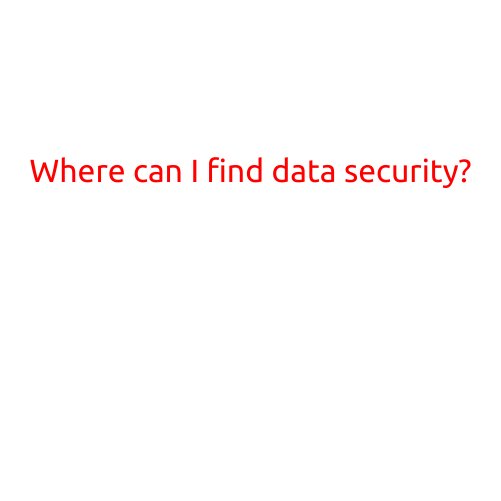
Where Can I Find Data Security?
In today’s digital age, data security is more important than ever. With the increasing threat of cyber attacks and data breaches, it’s crucial for individuals and organizations to prioritize the protection of their sensitive information. But where can you find reliable data security?
What is Data Security?
Before we dive into where to find data security, let’s quickly define what it means. Data security refers to the practices and measures taken to protect sensitive information, such as personal identifiable information (PII), financial data, and intellectual property, from unauthorized access, use, disclosure, disruption, modification, or destruction.
Where Can I Find Data Security?
Here are some places to find data security:
1. Encrypt Your Data
One of the most effective ways to ensure data security is to encrypt your data. Encrypting your data makes it unreadable to anyone who doesn’t have the decryption key. You can use encryption software or apps, such as Signal, ProtonMail, or TunnelBear, to encrypt your messages, emails, and online communications.
2. Use Secure Online Storage Services
Secure online storage services, such as Dropbox, Google Drive, or Microsoft OneDrive, offer robust security features to protect your files and data. Look for services that use end-to-end encryption, secure authentication, and access controls.
3. Install Antivirus Software and Firewalls
Antivirus software and firewalls are essential tools to detect and prevent malware and cyber attacks. Install reputable antivirus software, such as Norton or Kaspersky, and ensure your firewall is enabled to block unauthorized access to your devices and networks.
4. Use Strong Passwords and 2-Factor Authentication
Strong passwords and 2-factor authentication (2FA) are crucial to secure your online accounts. Use a password manager, such as LastPass or 1Password, to generate and store unique, complex passwords. Enable 2FA on all accounts that offer it to add an extra layer of security.
5. Keep Your Software and Operating System Up-to-Date
Regularly update your software and operating system to ensure you have the latest security patches and features. Outdated software can leave your devices vulnerable to attacks, so make sure to keep your systems up-to-date.
6. Use a Virtual Private Network (VPN)
When accessing public Wi-Fi networks or sensitive information online, use a VPN to encrypt your internet traffic and protect your data from eavesdropping.
7. Monitor Your Accounts and Credit Reports
Regularly monitor your online accounts and credit reports to detect any suspicious activity or identity theft. Use services like IdentityForce or Credit Karma to monitor your credit reports and receive alerts if any changes are detected.
8. Hire a Cybersecurity Professional
If you need additional protection or expertise, consider hiring a cybersecurity professional to assess your organization’s security posture and recommend solutions.
9. Use Data Loss Prevention (DLP) Tools
Data loss prevention (DLP) tools, such as DataLossPrevention.com or DLP Software, help detect and prevent unauthorized data exfiltration and insider threats.
10. Stay Informed
Lastly, stay informed about the latest cybersecurity threats and best practices by attending workshops, conferences, and online courses. Follow cybersecurity experts and organizations on social media to stay up-to-date on the latest developments and trends.
Conclusion
Data security is a critical component of protecting your sensitive information and identity. By following these tips and utilizing reliable security measures, you can ensure a safer digital life. Remember, data security is an ongoing process that requires vigilance, awareness, and proactive measures to stay ahead of potential threats.





